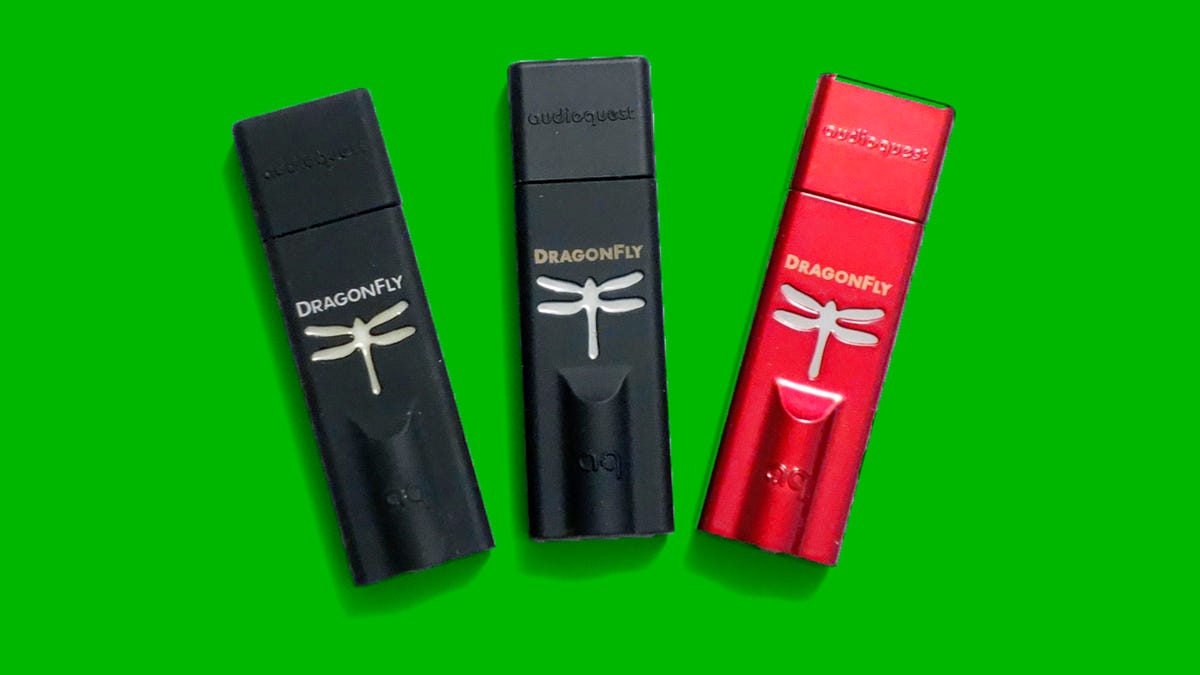These tiny (and affordable) gizmos will make your music sound better
Up, up and away with the two new AudioQuest DragonFly digital converter/headphone amplifiers.

I reviewed the original AudioQuest DragonFly USB digital converter back in 2012, so I was eager to check out a couple of the latest DragonFlys, the Black ($99, £89, AU$160) and the Red ($199, £169, AU$320). The Black looks pretty much like the older DragonFly, but the Red is finished in snazzy red metallic paint.
From left to right, the original DragonFly, DragonFly Black, DragonFly Red
For those two new ones, AudioQuest and DragonFly designer Gordon Rankin teamed up with Microchip Technology to develop a new USB microcontroller that's said to deliver improved signal-to-noise ratio and reduce battery power consumption, compared with those of the older DragonFly. AudioQuest says the new microcontroller also provides compatibility with Apple and Android smartphones and tablets, as well as laptops and computers. DragonFly bypasses the device's internal digital converters and headphone amplifiers for better sound. For hookup to Apple iOS devices you'll need to purchase an Apple Lightning-to-USB camera adapter; Android users will need AudioQuest's DragonTail USB adapter, which will be available later this month. With computers and laptops, just plug the DragonFly directly into a USB port.
Both new DragonFlys feature improved 32-bit ESS Sabre digital converters that handle up to 96 kHz/24-bit files, but alas, no DSD files. The DragonFly's LED changes color to indicate the sample rate of the music in play: green is 44.1kHz, blue is 48, amber is 88, and magenta is 96kHz.
DragonFly Black delivers up to 1.2 volts of output power -- that's enough to drive preamplifiers, receivers or desktop powered speakers, as well as most efficient headphones. The DragonFly Red's 2.1-volt output also works with a wider range of headphones, including some power-hungry, low-efficiency models.
But wait, there's more: according to AudioQuest, DragonFly Black and DragonFly Red are software upgradable through Windows or OS X desktop applications. As new developments in streaming protocols or new software come online, DragonFly users will be able to incorporate those updates.
DragonFly Red on a desktop system
I started listening to the Black with a set of Grado RS-1e full-size headphones, and it was the overall clarity of the sound that took centerstage. I felt like I was hearing deeper into the mixes of familiar recordings. The purity of the sound was addicting, so each instrument and vocal stood in bold relief. The RS-1e sounded like a higher resolution 'phone than I thought it was.
Comparing an original DragonFly with the DragonFly Black plugged into my Mac Mini computer and listening through NAD Viso HP50 and also Audio Technica ATH M50x over-the-ear headphones, the Black had a richer, more satisfying tonal balance, overall clarity was much improved, the original DragonFly sounded a little congested by comparison. Switching to the superb Audeze Sine on-ear headphones, the differences between the original DragonFly and DragonFly Black were even more clear-cut, and deep bass articulation and oomph were better on the Black. Stepping up to the DragonFly Red took the sound to the next level. The Sine's bass is stunning -- deep, tuneful and precise -- and the DragonFly Red lets you hear how good the Sine can be.
Then I put the DragonFlys aside and popped in the Apogee Groove ($295, £250, AU$459) USB converter/headphone amp, and frankly it was a letdown. The Groove was one of my favorites last year, but the Red smoked it! The Groove was nowhere as clear/transparent as the DragonFly Red with the Sines. The Red is more nimble -- you feel the music move, and rhythms are more agile with the Red, while the Groove took the energy down a peg or two.
A DragonFly Red with an iPhone 6S, and Audeze EL-8 headphones
All of the headphones I used up to this point had been easy to drive, so I next checked out something more challenging, my original Hifiman HE400 'phones, and again DragonFly Red scored. The HE400 is an even more transparent, more spacious-sounding headphone than the Sine, and I was surprised that the Red could play the HE400 quite loudly, plenty loud enough for me.
I also listened to the 'Black and 'Red plugged into my iPhone 6S. Again the sound impressed with some of the same headphones mentioned above. Then I tried a few in-ear headphones, starting with the Klipsch Reference X6i and Cardas A8, comparing the iPhone 6S' headphone jack with the sound of the Red. The difference in sound quality wasn't nearly as significant as it was with full-size headphones.
AudioQuest is on a roll, so the DragonFly Black and Red are easy to recommend to audiophiles seeking better sound, without spending a lot of cash.

